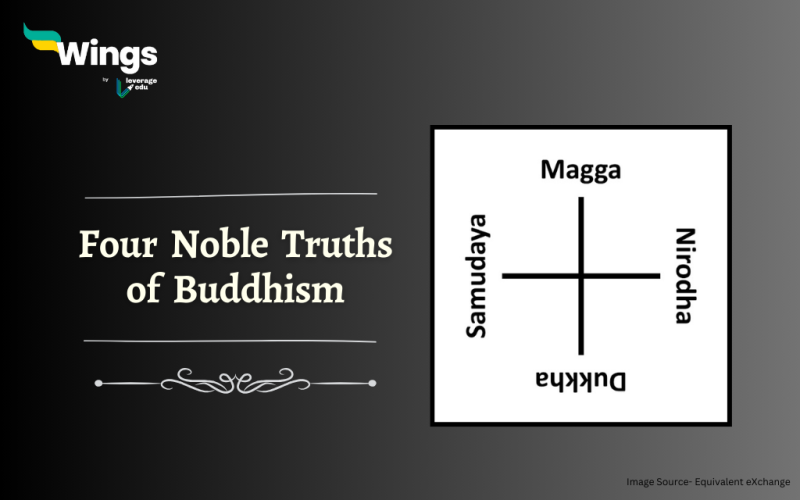The Four Noble Truths of Buddhism is one of the most important doctrines of Buddhism. It is widely believed that these four notions were set by Gautama Buddha, the founder of Buddhism, during his first sermon after achieving enlightenment. In simple words, they are the four facts that are known to be true by individuals who have a unique insight into the reality of this universe. Buddha also believed that only the person who gained absolute knowledge of the four truths is able to achieve enlightenment and freedom.
Table of Contents
Four Noble Truths of Buddhism for UPSC
The Four Noble Truths of Buddha are widely acknowledged by all schools and followers of Buddhism. Here is an overview of them:
1. Suffering: The First Truth
- Suffering, Dukkha in Pali, and dukkha in Sanskrit is the First Noble Truth.
- It states that life is full of suffering and will remain so as long as one refuses its true nature.
- Buddha explained different types of suffering such as ageing, birth, sickness, death, not gaining what one desires, and so on.
Also Read: What are the Noble Eight-Fold Paths of Buddhism?
2. Origin / Cause of Suffering: The Second Truth
- The Second Truth is the origin (Samudaya in Pali and Sanskrit) of suffering.
- Buddha associated the cause of our suffering with attachment and cravings for something.
- In numerous other Buddhist texts, the cause of suffering is often associated with certain negative actions like killing, stealing, and lying as well as negative mental states like hatred and ignorance.
Also Read: Gurukul Education System in Ancient India
3. Cessation of Suffering: The Third Truth
- The cessation or the end of suffering is the Third Truth of Buddhism which is known as nibbana.
- It is commonly called Nirodha in Pali and Sanskrit.
- Buddism states that pain or sorrow can be ended by attaining Nirvana.
4. Path to the Cessation of Suffering: The Fourth Truth
- The final Truth is called the path to the cessation of suffering.
- The path is called Magga in Pali and Marga in Sanskrit.
- Nirvana is understood as a profound state of mind which helps people attain enlightenment.
- It includes a set of principles which is known as the Eightfold Path or the Middle Way.
- The eight divisions include right understanding, right intention, right speech, right action, right livelihood, right effort, right mindfulness, and right concentration.
- These subdivisions are grouped into different categories such as Wisdom, Ethical Conduct, and Meditation.
The Ultimate aim for putting forward these truths by Buddha was to teach an individual the path of nirvana and to realise these truths and overcome them.
FAQs
The four noble truths of Buddhism in English include that there is suffering in life, the cause of suffering is attachment and cravings, suffering can come to an end, and finally, there is a path that leads to enlightenment.
The Buddha himself has reached nirvana or the stage of enlightenment.
The Second Noble Truth states that there is always an origin or cause of suffering. It is usually the person’s craving or attachment toward something.
The First Nobel Truth states that there is suffering or dukkha in our lives.
That is all about the four noble truths of Buddhism. If you want to read more articles like this, you can get Study notes on the Modern History of India here. Also, you can visit our general knowledge page on Indian History!
 One app for all your study abroad needs
One app for all your study abroad needs













